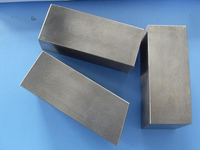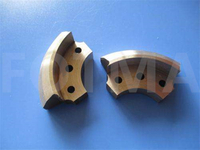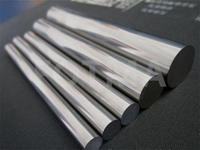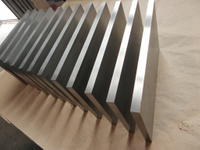Views: 3 Author: Site Editor Publish Time: 2010-04-17 Origin: Site
From the Swedish words tung sten, which mean "heavy stone." Tungsten's chemical symbol comes from its earlier, Germanic name, Wolfram. The name Wolfram comes from the mineral wolframite, in which it was discovered. Wolframite means "the devourer of tin" since the mineral interferes with the smelting of tin.
Tungsten is a lustrous and silvery white metal. The bulk metal resists attack by oxygen, acids and alkalis. Tungsten has the highest melting point of any metal.
Applications
Tungsten is used in filaments in incandescent light bulbs; it is also used in electric contacts and arc-welding electrodes. Tungsten is used in alloys, such as steel, to which it imparts great strength. Cement carbide is the most important use for tungsten: its main component is tungsten carbide (WC). It has the strength to our cast iron and it makes excellent cutting tools for the machining of steel. X-ray tubes for medical use have a tungsten emitter coil and the screen used to view X-rays rely on calcium and magnesiumtungstate phosphors to convert X-rays into blue visible light. Tungsten is also used in microchip technology and liquid crystals displays.
Tungsten in the environment
Very little tungsten has been detected in the dew soils that have been analyzed for it, although around an ore-procession plant in Russia levels as high as 2000 ppm were found. The concentration of the element in natural waters is very low.
There are several minerals of tungsten; the most important are scheelite and wolframite. The main mining area is China, which today accounts for more than two-thirds of the world's supply. Other places with active tungsten mines are Russia, Austria, Bolivia, Peru and Portugal. World production is around 40.000 tonnes per year and reserves are estimated to be around 5 million tonnes. Tungsten is also recycled and it meets 30% of demand.
Health effects of tungsten
Tungsten has been shown to act by antagonizing the action of the essential trace element, Molybdenum. Long industrial experience has indicated no pneumoconiosis to develop among workers exposed solely to W or its insoluble compounds (at air concentrations of the order of 5 mg/m3).
Acute health effects: Irritating to the skin and eyes on contact. Inhalation will cause irritation to the lungs and mucus membrane. Irritation to the eyes will cause watering and redness. Reddening, scaling, and itching are characteristics of skin inflammation. Follow safe industrial hygiene practices and always wear protective equipment when handling this compound.
Chronic health effects: This product has no known chronic effects. Repeated or prolong exposure to this compound is not known to aggravate medical conditions.
All tungsten compounds should be regarded as highly toxic. The metal dust presents a fire and explosion hazard.
Effects of tungsten on the Environment
Tungsten metal powder administered to animals has been shown in several studies as not altogether inert. One study found that guinea pigs treated orally or intravenously with tungsten suffered from anorexia, colic, and incoordination of movement, trembling, dyspnea and weight loss. This product is not expected to be hazardous for the environment. No specific ecotoxicity data is available for this product.
History and Uses:
Tungsten was discovered by Juan José and Fausto Elhuyar, Spanish chemists and brothers, in 1783 in samples of the mineral wolframite ((Fe, Mn) WO4). Today, tungsten is primarily obtained from wolframite and scheelite (CaWO4) using the same basic method developed by José and Elhuyar. Tungsten ores are crushed, cleaned and treated with alkalis to form tungsten trioxide (WO3). Tungsten trioxide is then heated with carbon or hydrogen gas (H2), forming tungsten metal and carbon dioxide (CO2) or tungsten metal and water vapor (H2O).
Pure tungsten is a light gray or whitish metal that is soft enough to be cut with a hacksaw and ductile enough to be drawn into wire or extruded into various shapes. If contaminated with other materials, tungsten becomes brittle and difficult to work with. Tungsten has the highest melting point of all metallic elements and is used to make filaments for incandescent light bulbs, fluorescent light bulbs and television tubes. Tungsten expands at nearly the same rate as borosilicate glass and is used to make metal to glass seals. Tungsten is also used as a target for X-ray production, as heating elements in electric furnaces and for parts of spacecraft and missiles which must withstand high temperatures.
Tungsten is alloyed with steel to form tough metals that are stable at high temperatures. Tungsten-steel alloys are used to make such things as high speed cutting tools and rocket engine nozzles.
Tungsten carbide (WC) is an extremely hard tungsten compound. It is used in the tips of drill bits, high speed cutting tools and in mining machinery. Tungsten disulfide (WS2) is a dry lubricant that can be used to temperatures as high as 500°C. Tungsten forms compounds with calcium and magnesium that have phosphorescent properties and are used in fluorescent light bulbs.
Tungsten Alloy
Tungsten Alloys containing about 85 to 95 percent tungsten by weight can be produced by liquid-phase sintering compacts of tungsten powder with nickel-copper, iron-nickel, iron-copper, or nickel-cobalt-molybdenum binders. In compact forms, these tungsten alloys can be machined by turning, drilling, boring, milling, and shaping; however, they cannot be wrought at any temperature and therefore are not available in mill forms. Heavy tungsten alloys can be used in aircraft applications, by the military in its weapons, in X-ray shielding, and even some consumer goods applications.
Light bulb filaments are usually made of unalloyed tungsten. Cutting tools are often made of tungsten carbide. Finally, tungsten is also an element of some of the modern super alloys.
All Metals & Forge (AM&F) is a leading supplier of tungsten alloys, specialty metals, designer alloys, super alloys, and other materials to clients in the U.S. and across the world. For more information on AM&F's many products services or to request a quote, please call (973) 276-5000, or send an email to info@steelforge.com. This site has also been designed to function as an information resource. You are also encouraged to browse it for information on metallurgy and the steel industry.
content is empty!





